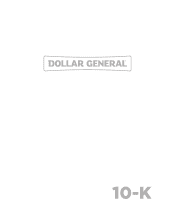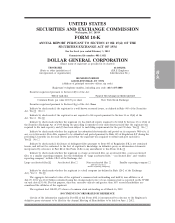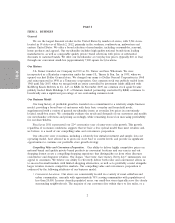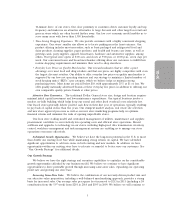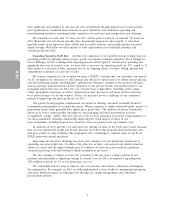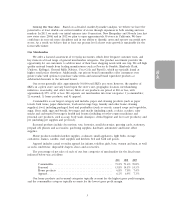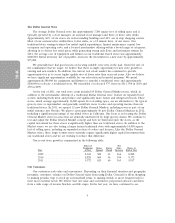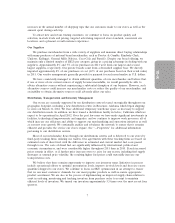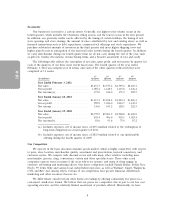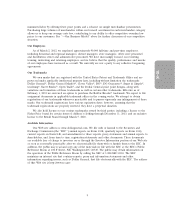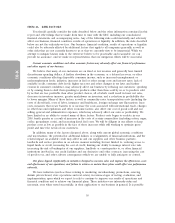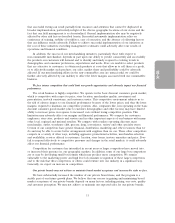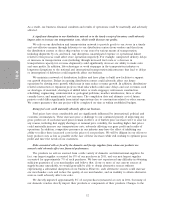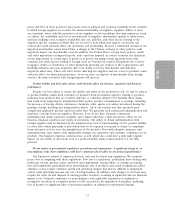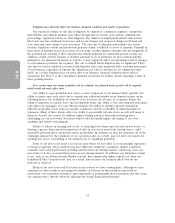Dollar General 2011 Annual Report Download - page 104
Download and view the complete annual report
Please find page 104 of the 2011 Dollar General annual report below. You can navigate through the pages in the report by either clicking on the pages listed below, or by using the keyword search tool below to find specific information within the annual report.
10-K
have additional opportunities to increase our store productivity through improved in-stock positions,
price optimization, continued improvements in space utilization, and additional operating and
merchandising initiatives, including further expansion of our frozen and refrigerated food offerings.
We remodeled or relocated 575 stores in 2011, and we plan to relocate or remodel 550 stores in
2012. Remodels and relocations typically drive incremental same-store sales growth. A relocation
typically results in an improved, more visible and accessible location, and usually includes increased
square footage. We believe we will continue to have opportunities for additional remodels and
relocations beyond 2012.
Expanding Operating Profit Rate. Another key component of our growth strategy is improving our
operating profit rate through enhanced gross profit and expense reduction initiatives. Even though we
faced challenges in 2011 resulting from ongoing pressures with regard to discretionary spending and
significant increases in product costs, we were able to increase our operating profit by 17%, equal to 30
basis points as a percent of sales, primarily due to our ongoing efforts to reduce selling, general and
administrative expenses as a percent of sales.
We remain committed to an everyday low price (‘‘EDLP’’) strategy that our customers can depend
on. To strengthen our adherence to this strategy and still protect gross profit, we utilize various pricing
and merchandising options, including price optimization strategies, changes to our product selection,
such as alternate national brands and the expansion of our private brands, and modifications to our
packaging and product size. In 2011, the cost of many basic commodities, including cotton, sugar,
coffee, groundnuts and resin, as well as transportation fuel, increased, and many of these increases
were passed along to us by our vendors. These cost increases posed a challenge to our continued
priority of improving our gross profit rate in 2011.
Our private brand program complements our model of offering customers nationally branded
consumables merchandise at everyday low prices. When compared to similar national brands, private or
proprietary brand items generally have higher gross profit rates. The addition of private brands also
allows us to better control quality and improve our packaging and shelf presentation over less
recognizable ‘‘packer’’ labels. Over the past few years we have expanded our private brand initiative to
our non-consumable offerings, dramatically improving the visual impact of many of our
non-consumables, including housewares, domestics, lawn and garden tools and summer toys.
In addition, in 2010 and 2011, we increased our offering of items at the $1.00 price point, focusing
first on food followed by health and beauty. Because we believe this program adds incremental sales
and gross profit, we plan to further this program in 2012, continuing to combine some of our $1.00
EDLP items with special purchases.
Improving our inventory shrinkage has been and continues to be an important component of
expanding our gross profit rate. To achieve this objective we have concentrated our shrink reduction
efforts on stores with the highest shrink rates. In addition, we have been successful in employing
exception reporting tools and enhanced shrink optimization processes.
We also continue to believe we have the potential to directly source a larger portion of our
products internationally at significant savings to current costs. In 2011, we imported approximately
$780 million of goods, or 8% of total purchases, at cost.
We continually look for ways to improve our cost structure and enhance efficiencies throughout
the organization. For example, in 2011, we fully implemented a store workforce management program,
and made further progress on reducing costs through our energy management and centralized
procurement systems.
4





